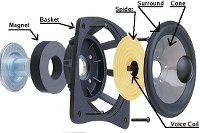Here they are.. They may or may not work for you..
"If you have a glare in the sound, that means your highs are too extended.When your system high is sticking out too much, then the it begins to bother the human ear a lot.
To fix the high you need to work on the low. If you have no low then you work on the high. These are related by the overtone harmonics in resonance of acoustics.
1. Go find some cloth fabric material. One is silk and one is wool. Silk I am sure you have fine Indian silk, not rough Thai silk, chinese smooth silk but not too thick threads. Cut a small tiny piece about half inch square, roughly. Need two pieces. Use a simple household glue, one that you can clean up with water. Stick silk piece next to high tweeter. Usually right next to dome, or ribbon. This will smooth out the high.
2. Get a wool cloth like the one school children use for uniform, jacket or trousers. Cut a round piece size of 3/4" round. Glue this to the metal ring of the driver.
Try these two things on tweeter and bass driver and see what happens.
Do not use too much glue, just take a tooth pick and dip one drop for sticking silk. Maybe 3 dots for the wool dot."
3. Check for the correct phasing of your power. In a typical room the power receptacles on each wall will be fed by different phase of the electricity coming into the house. You should try to have all of your components plugged into the same phase of power. If this cannot be done try to keep the CD, DA, Preamp to one receptacle and the power amps to another receptacle. For old homes without three prong receptacles you have lucked out and can try to listen to a component plug in one way, then flip the plug and listen to it the other way. One way always sound better then the other, mark this side and always plug it in the same way.
4. Typically a domestic room could cause standing waves in the corner. A cheap and better way to solve this is to use cardboard carton boxes stuffed with paper products (magazine, newspaper etc) stack them in the corners to tune out the excess booming. You can use three sizes of carton boxes, large, medium and small, one set for each corner. Stuffing the boxes full gives a tighter sound while a loose packing will increase the low frequency One must use patience to do this several time to get the right combination.
5. Often time furniture and decorative objects in your room can have a negative reaction with the acoustics. Glass, steel, copper etc will make the sound bright and harsh while carpet, curtains, sofas etc will soften the tone. Pay attention to the material you use to hold up your equipment. Marble sounds soft, granite sounds cold, glass sounds bright, steel sound harsh and MDF is worst material for acoustics as it is full of glue and retards any musical vibration to that is good. Natural material like wood, cotton, paper are all good sounding material.
6. Parallel components - Electronic equipment must not be parallel to each other due to the magnetic field of each transformer interfering with the other. If you have two mono block power amps usually placed nice and neat to each other, try and turn one of them slightly to a few degrees, you should hear some improvement in the clarity of your music. If you have pre-amp and other electronics stacked one on top of each other, then do the same by move either piece a few degrees you will notice a difference."
I would like to add that a good earth can do wonders to cure RF and EMI. If your equipment power cable supports earthing USE it. If not, you can try connecting your equipment chassis to earth with a simple wire - please do this at your own risk and only if you know what you are doing - if you put the wire in the wrong hole, the consequences can be dire.


